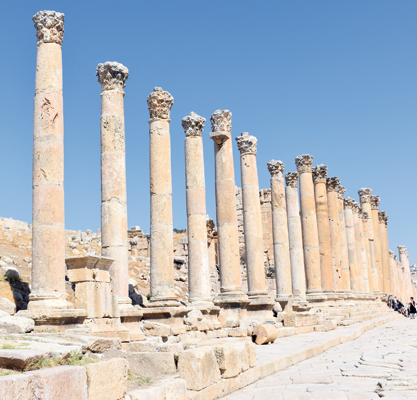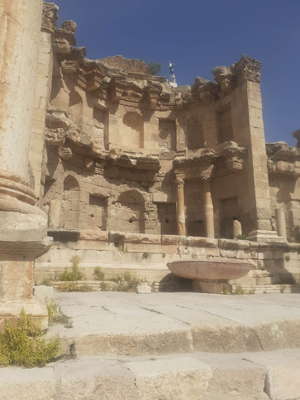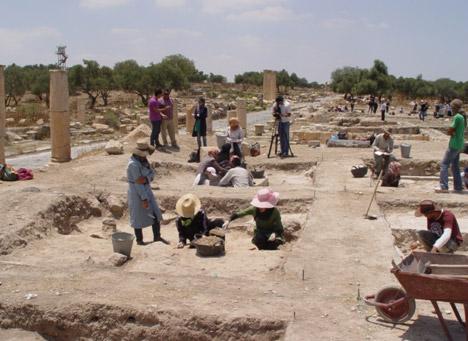You are here
American scholar examines ancient water systems in Jerash, Umm Qais, Amman
By Saeb Rawashdeh - May 29,2023 - Last updated at May 29,2023

A fountain type found in between the columns in Jerash (Photo courtesy of Clare Rasmussen)
AMMAN — A PhD candidate in the Department of Classical and Near Eastern Archaeology at Bryn Mawr College in Pennsylvania is conducting a study on the remains of urban water supply systems in Jerash, Umm Qais and Amman.
“My methodology uses a network-based approach to recreate the water supply routes. With these established supply routes, I can better understand how water was moved within a city, and what types of buildings and features consumed water,” noted Clare Rasmussen who was also a pre-doctoral fellow at American Centre of Research.
Rasmussen is conducting her research by analysing and documenting previously excavated water features like fountains, reservoirs, channels, cisterns and basins.
Overall, her comparative study focuses on water supply practices within the Decapolis region and the larger Roman Near East.
Jerash and Umm Qais follow similar water supply routes, as the main supply runs down the main colonnaded thoroughfare, Rasmussen noted, adding that in Jerash, it the thoroughfare is the main north-south street, and in Umm Qais is the east-west street.
Both cities received water from springs, conveyed through aqueduct channels and tunnels that were built to bring water to the cities.
“Jerash has several different aqueducts dating to different periods, from the 1st -3rd centuries AD that facilitated water supply to different parts of the city; and Jerash has at least four water supply routes…The water supply route stayed in use through the Byzantine and early Islamic periods with some modifications,” Rasmussen elaborated.
Umm Qais has the earliest aqueduct, dating to 1st century BCE, which tunnelled through the acropolis, Rasmussen said, adding that prior to the Roman period, the city was fixed on the acropolis and used rock-cut cisterns to store water.
“Umm Qais also has the longest Roman aqueduct tunnel at 170km long. The water supply of Umm Qais ran down the colonnaded street [east-west] towards the west city gate in a basalt pipeline. It likely supplied water to buildings on the north and south side of the street,” Ramussen said.
As for Amman, the city’s ancient inhabitants constructed two distinct types of water systems.
“On the citadel, a network of rain-fed cisterns, wells and drains are scattered throughout both the lower and upper terraces. The Umayyad palace was built over a monumental Roman building, and it reused many of the Roman architectural walls and blocks, and possibly the cisterns and drains as well,” Rasmussen said.
In the Roman period, there was likely an aqueduct, as early modern accounts mention an aqueduct called “Al-qanahar-Rumanieh” near the Ras Al Ain area.
“It ran along the south side of the Jabal Amman, reaching the area of the Husseini Mosque. From there it fed the nymphaeum fountain, which also served as a place of redistribution,” Rasmussen explained, adding that the water would have supplied the newly discovered bath complex found in 2020, as well as the forum area, contemporarily known as The Hashemite Plaza.
Related Articles
AMMAN — Although the ancient sites of Ammon, Gerasa and Umm Qais share similarities with other sites in the Decapolis, the Levant, North Afr
AMMAN — A “first-of-its-kind” Hellenistic temple in the Levant region has been discovered in Umm Qais, an archaeologist said on Monday.An ar
AMMAN — During the Hellenistic-Byzantine period (200BC-630AD), a networked water supply was found on the west side of Gerasa (modern da


















